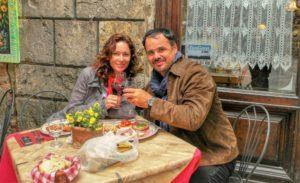An amazing city, Montreal is many things to many people. It has always been at the confluence of many things. It’s the home of both French Canada and generations of English-Canadians, it is the meeting place in the river, and it is where some of the country’s most haute-cuisine are found alongside 5$ greasy sandwiches. In the 1920s and 30s during prohibition in the U.S, Montreal was the mecca of partying and fun-seeking for folks in New York, Boston, and around New England. While some things have changed since then, Montreal still enjoys its reputation as a fun-having city and a place where cultures blend together seamlessly and where the concept of joie de vivre is taken seriously.
Montreal is the cultural and economic driver of Quebec and is the second-largest city in Canada. It was one of the first cities in the country established by French missionaries in the 1600s. Montreal is an island and situated in the middle of the St. Lawrence River it was even before the arrival of Europeans, as a central meeting point for many of the area’s native people. Upon the establishment of a city, the area grew because of its strategic location for the fur trade of the 1700s. In 1762, the city (and the territory of New France) was conquered by the English establishing Montreal as a prominent English-controlled economic powerhouse, populated by French speakers.
After San Francisco, Montreal is the culinary capital of North America, and the diversity of food options here is unmatched. So if you’re visiting the city, here’s what and where to eat when you’re in La Métropole.
Poutine
No trip to Montreal is truly complete without indulging in the province’s pride and joy dish – poutine. The concept of the dish is simple but it is also easy to get wrong. Consisting of french fries that are medium cut in thickness, more similar to British-style “chips”, the fries are usually fried twice so they’re extra crispy yet still soft on the inside. Following that are cheese curds made from cheddar cheese. The freshness of the curds is essential and they must squeak when rubbed together. Shredded cheese or other types of cheese won’t cut it. After that comes the gravy. Poured on top, the gravy is brown gravy, usually light and made with chicken stock and mixed with spices and a distinct pepper flavor. A combination of beef and chicken stock is also acceptable but the gravy should be light enough to coat the entirety of the fries, while also being thick enough where it’s not too watery. The heat of the gravy warms the curds without melting them.
- La Banquise: The origins of the dish are disputed, but La Banquise is said to be the first restaurant in Montreal that started serving the dish “authentically” in the early 1970s. The restaurant remains a favorite for many in the city with fun variations of the dish as well as vegan options available as well. The late Anthony Bourdain ate here and proclaimed it was a “thoroughly wonderful gastronomic trainwreck” and that he “fe[lt] so dirty, yet so alive.
- Chez Claudette: Those “in the know”, skip the line at La Banquise and head to the nearby Chez Claudette. The little mustard yellow corner shop is easy to spot and just as good as anywhere else in the city. It’s also cheaper than a more touristy Banquise, and it has just as many options available too. After a night of heavy drinking, head over to Chez Claudette and load up on carbs. The restaurant is open late.
- Maam Bolduc: This little poutinerie has been a staple in the Plateau area for over 50 years. It is truly a local spot and the only day they close is on Christmas. They also offer beer on tap, homemade veggie burgers, and poutine plates bigger than any reasonable person should eat.
Smoked Meat
Montreal has a long history with immigrants and one of the biggest groups of immigrants to the city in the early 20th century were European Jews. With them came a plethora of culinary traditions one of which is the legendary smoked meat sandwich. Similar to poutine, the Montreal-style smoked meat sandwich is something that you can get in various places throughout the city but the only “authentic” way to eat the sandwich is on rye bread with mustard and nothing else. No cheese, no slaw, just mustard. Again, similar to poutine, the origins of the dish are unknown although most evidence points to the Eastern European Jewish immigrant community. While the sandwich has often been compared to the New York pastrami, the difference lies in the spices used and the cut of the meat used before the curing process.
- Schwartz’s: For many, this is the place to get a smoked meat sandwich. Author Mordechai Richler described the meat at Schwartz’s as a “maddening aphrodisiac” and that it should be sold as the “Nectar of Judea”. The reality is that the restaurant was started in 1928 by Romanian-Jewish immigrant Reuben Schwartz. Its long life and popularity has effectively made it a cultural landmark in the city. The restaurant has been the subject of numerous documentaries and films including one musical.
- Snowdon Deli: Serving much more than just smoked meat, Snowdon deli is another classic Montreal institution. In 1946, Abe and Joe Morantz opened the deli and for over 40 years the restaurant has stayed within the family.
Bagels
When it comes to bagels in Montreal, people have their favorite and the options are abundant. While “Montreal-style” bagels are sold in plenty of shops and bakeries in the city, the question of “who’s bagels do you prefer?” usually means one of two options; St-Viateur or Fairmount. But what makes a Montreal bagel unique? In comparison to its New York counterpart, Montreal-style bagels are a bit thinner and denser. They’re made with eggs and boiled in honey-water before being cooked in a wood-burning oven which makes them a bit sweeter and results in a crunchy, crust-like exterior with a soft doughy interior.
- Fairmount: Located in the Mile-End neighborhood, Fairmount Bagels have been a Montreal institution since 1919. Arguably the “home” of the Montreal-style bagel, the bakery remains a family-owned and operated business making bagels the exact same way they did when they started over 100 years ago. In 2008 Fairmount Bagels also went into space.
- St-Viateur: The rival to Fairmount bagels, St-Viateur bagels is essentially located right around the corner. The shop was started in 1957 by a Holocaust survivor who at Buchenwald “dreamt of a piece of bread”. He established the shops after learning the trade at another Montreal bakery and soon St-Viateur became one of the trademark Montreal bagel shops.
Caribbean
The Caribbean diaspora of Montreal is large and if you know where to look, you’ll be treated to some of the best jerk chicken, stewed goat, and fried plantains outside of the islands. Thanks to the sharing of the French language, Montreal has a particularly large Haitian community though Jamaican and Trinidadian populations are also in high numbers in the city. If you’re looking to warm up a little in the cold winter, here’s where to go.
- Kwizinn: “Kwizinn” being Haitian creole for the French word “cuisine” meaning “kitchen”, this Haitian restaurant consistently is a favorite in the Haitian community. If you’re looking for authentic Haitian flavors, Kwizinn offers some of the best griots, tassot cabrit, and créole lambit. Staying true to its namesake the location is mostly for the take-out inclined although their second location in Verdun offers more of a sit-down atmosphere.
- Kamúy: Leaning on the more upscale side is the beautiful Kamúy. Located in the heart of the entertainment area, Kamúy is a central location that offers a more pan-Caribbean experience. Drawing on inspiration from typical markets found around the area, the chefs at Kamúy hail from throughout the Caribbean bringing different culinary tapestries to the restaurant’s menu. The dishes change according to the seasons so there’s always something different to check out.
- Seasoned Dreams: Tucked away in a little industrial part of town, Seasoned Dreams has made a name for itself for its fusion of spicy Caribbean classics and Quebecois favorites. After having local success and a stint on Top Chef, the owner of Seasoned Dreams opened a second more casual sit-down location. Expect a range of delicious offerings such as jerk pork and chicken or Caribbean-style mac and cheese. If it’s your cheat day and you’re feeling adventurous, opt for the “Cardiac Arrest” – which is poutine topped with their homemade mac and cheese topped with chunks of jerk pork and slathered in sauce. It is as decadent as it sounds.
Upscale
While the city is full of affordable and delicious places to grab a bite, there are also a wide number of more upscale dining establishments. The downtown area around the “Place des Festivals” as well as the Old Port is where you’ll find a good number of classic French-style bistros as well as some more contemporary and modern restaurants. While these places are good, it’s an area mostly catered to tourists, and checking out other neighborhoods will yield you a more “local” dining experience.
- Joe Beef: Not only is it one of Montreal’s most popular restaurants but it’s arguably one of the most popular in Canada. The restaurant might not seem like it is an upscale dining experience but it’s the quality of the dishes that matter in this context. Walking in you’ll notice the atmosphere feels more like a local pub rather than a high-end restaurant. Brick walls, a blackboard menu, and a stag head on the wall give Joe Beef a relatively casual feeling. The menu is both creative while also leaning heavily on the concept of simplicity. Lobster pasta is arguably the most famous dish here served with a pound of lobster, although other meats like veal, rabbit, and horse steak also are options. Their smoked ham is smoked in their smoker located in the backyard where they also grow a large number of their own veggies and produce. In fact, Joe Beef is so big on making its things that they even serve their own beer and distill their own absinthe. The menu rotates seasonally and always offers a plethora of meaty options paired with imported French red wine. If you plan on eating here, book well in advance.
- Au Pied du Cochon: Translating to “at the pig’s foot” you’ll notice that the name of the restaurant is pretty apt. Chef Martin Picard helped put the Montreal food scene on the map with this restaurant leaning into quintessential Quebecois flavors and dishes and elevating them to a sometimes ridiculous degree. Located in the hipster Plateau neighborhood, Au Pied du Cochon is all about protein. Local vegetables and grains are plated alongside creations such as braised pigs hoof, duck in a can served with foie gras and cabbage, pork tongue with tarragon, and the essential foie gras poutine.
- Restaurant Park: In a world where getting sushi is easy, Restaurant Park takes the sushi experience to another level. Headed by chef Antonio Park, the restaurant blends classic sushi dishes with Park’s own South American heritage to bring you plates such as butterfish nigiri topped with pickled jalapeno or beef tataki adorned with kimchi. Park opened the restaurant in 2012 and the large windows overlooking Victoria Street (in one of the city’s poshest neighborhoods) has been a favorite amongst visiting celebrities from Drake to Tom Cruise, and Katy Perry.
Our Final Word
Montreal in many ways is a bit of Europe close to America. It is where you can find more French speaking people than English. It was founded in 1642 so there is a lot of history and architecture to explore and discover. It has recently been named the 12th Most Livable City in the World and is an UNESCO City of Design. Kati and I find Canada incredible to explore and so different in attitude than America. We love it. So when you are trying to decide a place to visit for a few days, weeks or months, think of Montreal. It truly is a gem.
1 Comment
Submit a Comment
Related Posts
The Human Connection: Why We Should Care About People We Meet on Our Travels
“The Human Connection” explores the profound impact of human interactions during travels. It emphasizes the importance of embracing local cultures, understanding diverse perspectives, and forming meaningful connections. This post encourages readers to see beyond tourist spots and delve deeper into the heart of the places they visit, through the people they meet.
The Ultimate Guide to the Best Thanksgiving Destinations in the US
Discover the top Thanksgiving destinations in the US in our Ultimate Guide. From the historic charm of Plymouth, Massachusetts to the vibrant Macy’s Parade in New York City, we’ve got you covered. Explore unique traditions, mouthwatering feasts, and stunning fall landscapes that make these locations the perfect backdrop for your Thanksgiving celebration.
Where to find the best Macarons – The Parisian Treat
The Best Macarons in Paris is a guide to the best macarons in the City of Lights. From the classic flavors of vanilla and chocolate to the more exotic flavors of rose and lavender, this guide will take you on a journey to discover the best macarons in Paris. With detailed descriptions of each macaron, you’ll be able to find the perfect treat for any occasion. So come along and join us on our quest to find the best macarons in Paris!










Cant wait to have a bit of Montreal smoked meat. Great job and thanks for sharing